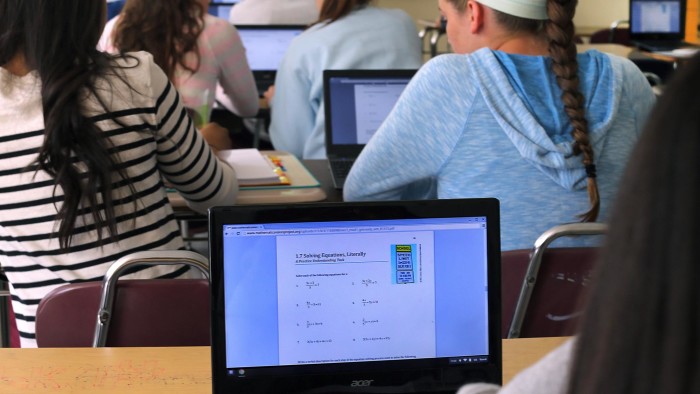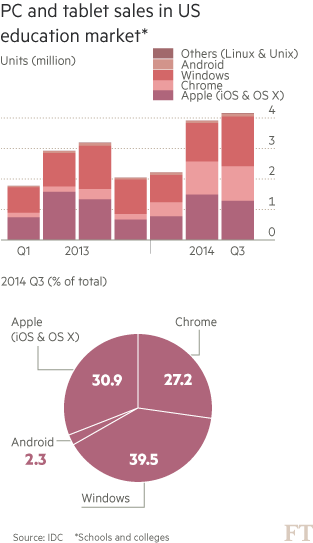Google overtakes Apple in the US classroom

Roula Khalaf, Editor of the FT, selects her favourite stories in this weekly newsletter.
Apple has lost its longstanding lead over Google in US schools, with Chromebook laptop computers overtaking iPads for the first time as the most popular new device for education authorities purchasing in bulk for students.
Google shipped 715,500 of the low-cost laptops into US schools in the third quarter, compared with 702,000 iPads, according to IDC, the market research firm. Chromebooks, which sell for as little as $199, have gone from a standing start two years ago to more than a quarter of the market.
It marks the first time Google has outsold its rival and consolidates a lead it opened up over Apple this year in the broader education market, which includes higher education establishments, as it closes in on Microsoft Windows, the market leader.
The multibillion-dollar education market has become a battleground for hardware makers trying to win the loyalties of the next generation of consumers. It has traditionally been dominated by Windows devices, which have a decades-long head start on iPads and Chromebooks, but schools are increasingly turning to cheaper alternatives.
“Chromebooks are really gaining traction,” said Rajani Singh, analyst with IDC. “The growth of Chromebook is a major concern for Apple’s iPad.”
Samsung, HP, Dell and Acer make Chromebooks and have been active promoting the device to school districts, she added. Low upfront costs and simpler device management for schools’ IT departments has increased their appeal, compared with Apple’s more expensive tablets, the prices for which start at $379 for last year’s iPad Air when including a discount for schools.
While the iPad’s touchscreen makes it a versatile device, the Chromebook’s integrated keyboard is also a factor in its appeal. “As the average age of the student grows the need for a keyboard becomes very important,” said Ms Singh.
Apple retains a slight lead over Google in schools and colleges when sales of its MacBook laptops, using the OS X operating system, are included.
However, IDC’s finding is the latest sign that the iPad’s early growth spurt is slowing across the board, even in a market that has traditionally been strong for Apple.
The iPad became the fastest-growing product in Apple’s history in the years after its launch in 2010, but iPad revenues fell 14 per cent year-on-year in Apple’s September quarter, as customers upgraded their devices more slowly than many analysts expected.
The company has worked hard to get iPads into US school districts, with mixed results. A high-profile plan to give an iPad to every student in the vast Los Angeles Unified School District – the second largest in America – was scrapped last year amid controversy over the tender process. Pearson, which owns the Financial Times, had partnered with Apple on the $500m deal, to provide educational software. LAUSD has since opted for Chromebooks and Windows-based laptops instead.

Tim Cook, Apple’s chief executive, said earlier this year that the iPad was “instantly a hit” in education, with more than 13m iPads sold to customers directly in that market in its first four years at the midpoint of this year, up from 8m in early 2013.
Apple, which declined to comment, still dominates tablet sales in education, according to IDC. More than 75,000 educational apps are available in the App Store, teachers can create courses in the free iTunes U app and publishers can make their own textbooks for the iBooks store.
Late last year, the launch of Google Play for Education, a customised version of the search company’s app store, brought improvements to how teachers and students can find apps and to how IT departments can manage Chromebooks and Android-based tablets.
Comments